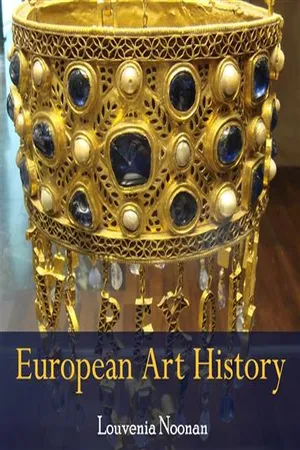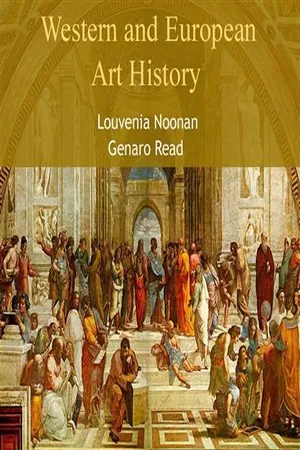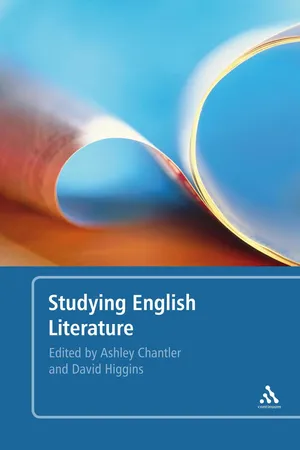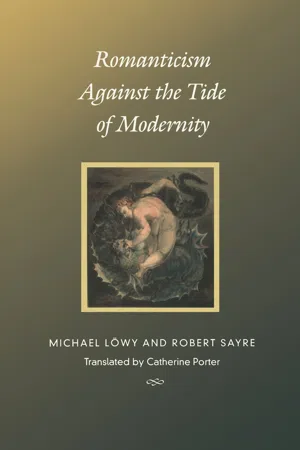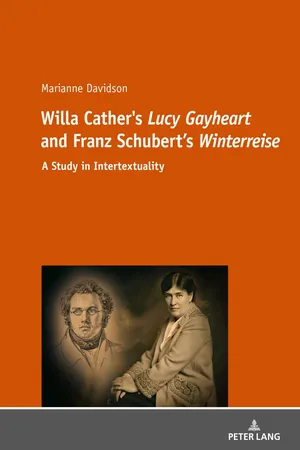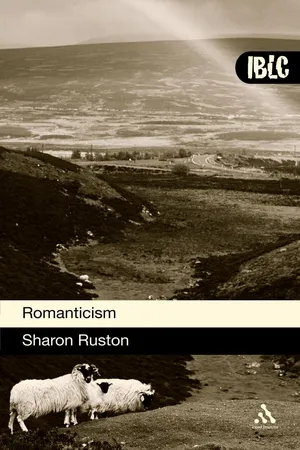Literature
Romanticism
Romanticism in literature was a movement that emerged in the late 18th century, emphasizing emotion, individualism, and the beauty of nature. It rejected the rationalism of the Enlightenment and sought to evoke strong emotions in readers through vivid imagery and passionate storytelling. Romantic literature often explored themes of love, heroism, and the supernatural, and it had a lasting impact on the development of literary expression.
Written by Perlego with AI-assistance
Related key terms
1 of 5
10 Key excerpts on "Romanticism"
- No longer available |Learn more
- (Author)
- 2014(Publication Date)
- The English Press(Publisher)
The modern sense of a romantic character may be expressed in Byronic ideals of a gifted, perhaps misunderstood loner, creatively following the dictates of his inspiration rather than the mores of contemporary society. Although the movement was rooted in the German Sturm und Drang movement, which prized intuition and emotion over Enlightenment rationalism, the ideologies and events of the French Revolution laid the background from which both Romanticism and the Counter-Enlightenment emerged. The confines of the Industrial Revolution also had their influence on Romanticism, which was in part an escape from modern realities; indeed, in the second half of the 19th century, Realism was offered as a polarized opposite to Romanticism. Romanticism elevated the achievements of what it perceived as heroic individualists and artists, whose pioneering examples would elevate society. It also legitimized the individual imagination as a critical authority, which permitted freedom from classical notions of form in art. There was a strong recourse to historical and natural inevitability, a zeitgeist , in the representation of its ideas. Characteristics In a basic sense, the term Romanticism has been used to refer to certain artists, poets, writers, musicians, as well as political, philosophical and social thinkers of the late 18th and early to mid 19th centuries. It has equally been used to refer to various artistic, intellectual, and social trends of that era. Despite this general usage of the term, a precise characterization and specific definition of Romanticism have been the subject of debate ________________________ WORLD TECHNOLOGIES ________________________ in the fields of intellectual history and literary history throughout the twentieth century, without any great measure of consensus emerging. - No longer available |Learn more
- (Author)
- 2014(Publication Date)
- College Publishing House(Publisher)
The modern sense of a romantic character may be expressed in Byronic ideals of a gifted, perhaps misunderstood loner, creatively following the dictates of his inspiration rather than the mores of contemporary society. Although the movement was rooted in the German Sturm und Drang movement, which prized intuition and emotion over Enlightenment rationalism, the ideologies and events of the French Revolution laid the background from which both Romanticism and the Counter-Enlightenment emerged. The confines of the Industrial Revolution also had their influence on Romanticism, which was in part an escape from modern realities; indeed, in the second half of the 19th century, Realism was offered as a polarized opposite to Ro-manticism. Romanticism elevated the achievements of what it perceived as heroic individualists and artists, whose pioneering examples would elevate society. It also legitimized the individual imagination as a critical authority, which permitted freedom from classical notions of form in art. There was a strong recourse to historical and natural inevitability, a zeitgeist , in the representation of its ideas. Characteristics In a basic sense, the term Romanticism has been used to refer to certain artists, poets, writers, musicians, as well as political, philosophical and social thinkers of the late 18th and early to mid 19th centuries. It has equally been used to refer to various artistic, int-ellectual, and social trends of that era. Despite this general usage of the term, a precise characterization and specific definition of Romanticism have been the subject of debate ________________________ WORLD TECHNOLOGIES ________________________ in the fields of intellectual history and literary history throughout the twentieth century, without any great measure of consensus emerging. - eBook - PDF
- Ashley Chantler, David Higgins, Ashley Chantler, David Higgins(Authors)
- 2010(Publication Date)
- Continuum(Publisher)
Part III Studying Romantic and Victorian Literature (1789–1901) This page intentionally left blank The Romantic Period 7 David Higgins Chapter Overview Historical Context 113 Key Authors and Texts 117 Criticism and Literary Theory 123 Case Study: William Wordsworth’s Poetry 126 Case Study: Jane Austen’s Pride and Prejudice 129 Further Reading 133 Historical Context The ‘Romantic Period’ is tricky to pin down. It generally refers a period from about 1780 to about 1830, but there is no consensus over precise start or end dates. The problem is that the adjective ‘Romantic’ and its associated noun ‘Romanticism’ are used to describe a diverse set of responses to com-plex socio-cultural changes that took place in western Europe during about a century. Critics and historians have struggled over the years to define Romanticism and A. O. Lovejoy famously argued in ‘On the Discrimination of Romanticisms’ (1924) that the term was used so broadly that it had become effectively meaningless. Romanticism has tended to be associated with certain concepts and areas of human experience: for example, feeling, revolution, the imagination, nature, and introspection. It has often been contrasted with eighteenth-century literature’s emphasis on reason, order, imitation, urban life, and sociability. However, once you start to unpack these grand general-izations, they become increasingly hard to sustain. For example, plenty of eighteenth-century literature is introspective, and plenty of Romantic litera-ture is interested in sociability (see Cox; James; and Russell and Tuite). And, as discussed in the previous chapter, the focus on the relationship between self and landscape that you see in many Romantic-period texts has its roots 113 in the work of eighteenth-century poets such as Collins, Cowper, Gray, and Thomson. - eBook - PDF
European Literature from Romanticism to Postmodernism
A Reader in Aesthetic Practice
- Martin Travers(Author)
- 2006(Publication Date)
- Continuum(Publisher)
Part I Romanticism This page intentionally left blank Romanticism began in the late eighteenth century as a broad movement of protest against the aristocratic culture of the ancien regime and against the neo-classical aesthetic upon which that culture was based. The movement had its precursors in writers such as Samuel Richardson (Pamela, 1740, and Clarissa, 1748), George Lillo (The London Merchant, 1731), Denis Diderot (Father of the Family, 1758) and Gotthold Lessing (Miss Sara Simpson, 1755), whose work sought to give validity to the claims for power of a swiftly ascending mercantile middle class, its material base secured by the achievements of the Industrial Revolution and its moral self-image sustained by the Protestant Ethic. Against what was seen as an increasingly corrupt and parasitic aristocratic ruling class these writers pitted characters from humbler backgrounds who combined depth of feeling with a supreme moral probity -which, in its unflagging commitment to private virtue (and in its conviction to use this virtue to judge the mores of the public realm), could not but have, as subsequent historical events confirmed, implications of a social and ultimately political nature. The early exponents of the Romantic movement, figures such as Edward Young, James Macpherson, Johann Gottfried Herder and Jean-Jacques Rousseau (the major names in what is now known as Pre-Romanticism), may have lacked the ideological momentum of these 'bourgeois' writers, but they did retain the emotive (larmoyant) rhetoric of their work, deepening Diderot and Richardson's idealization of heightened 'sensibility' (a term that combined for this generation both aesthetic and moral experience) into a more self-conscious ethos of personal and aesthetic authenticity. - eBook - PDF
- Michael Löwy, Robert Sayre, Catherine Porter, Fredric Jameson, Stanley Fish, Catherine Porter, Fredric Jameson, Stanley Fish(Authors)
- 2002(Publication Date)
- Duke University Press Books(Publisher)
At the same time, a cult of sentiment and subjectivity was emerging, with an emphasis on their lugubrious and melancholic dimen-sions, along with a celebration of nature and a critique of the market spirit and industrialization. Nostalgia for the past is manifested in particular in the Ossianic poems (1762) of James Macpherson; in the Gothic novel, beginning with Horace Walpole’s Castle of Otranto (1764); and also in the fashion for imitating various ancient styles in architecture and the decorative arts. Regarding sentiment and nature, let us mention the Graveyard School of Thomas Gray, Edward Young, and William Collins. And let us cite one example among many others, Oliver Goldsmith’s ‘‘The Deserted Village’’ (1770), a poem that brings all these themes together and denounces the commercialization of England from a Tory perspective: redefining Romanticism 53 Ill fares the land, to hastening ills a prey, Where wealth accumulates and men decay . . . But a bold peasantry, their country’s pride, When once destroyed, can never be supplied. A time there was, ere England’s griefs began, When every rood of ground maintained its man; For him light labour spread her wholesome store, Just gave what life required, but gave no more . . . But times are altered; trade’s unfeeling train Usurp the land and dispossess the swain. . . . ∞∞∑ France The movement of ideas in France was very heavily dominated by the Ency-clopedia and the Enlightenment in the second half of the eighteenth century. Early French Romanticism was expressed mainly in the arts and literature but was also found in religion, especially starting around 1770 with the burgeoning of illuminist and theosophic sects, which were often apocalyp-tic, millennial. - eBook - PDF
Willa Cather's «Lucy Gayheart» and Franz Schubert's «Winterreise»
A Study in Intertextualtity
- Marianne Davidson(Author)
- 2018(Publication Date)
- Peter Lang Group(Publisher)
13 2. Romanticism: An Attempt at Definition Have you always longed for a trip to a romantic island in the South Seas? What about the romantic Lake District in England or a small town along the Roman- tic Road in southern Germany? Your accommodation can be a hotel blending luxury with Romanticism or even a romantic monastery� An island vacation may afford you a romantic walk on the beach, a romantic swim by a waterfall while bathing in romantic moonlight� No matter where your romantic desires will take you, a romantic candle-light dinner with a romantic type, possibly leading to a romantic tryst that fulfills your romantic dreams may be available independently of your whereabouts� It all depends on your heightened sensitivity to the roman- tic promises of life� Now, how would the tourist industry for one fare without what the word ‘romantic’ so universally and powerfully connotes? Commercial- ized and subjected to many different purposes, ‘romantic’ and ‘Romanticism’ have been misused, overused, corrupted and thereby experienced catachresis if not eventual voiding of meaning� Still, the words would not be in such wide circula- tion if they did not evoke all sorts of mental and emotional notions and images contingent on individual experiences and needs� Since a virtual encounter between a “romantic youth” (the wanderer of Franz Schubert’s song cycle Winter Journey) and a “romantic young woman” 1 (the female protagonist of Willa Cather’s novel Lucy Gayheart) is to be arranged for here, a more serious yet tentative attempt at definition must be made� Books of refer- ence such as literary dictionaries are certainly useful quarries to be mined and so one finds the information that the German man of letters Friedrich Schlegel (1772–1829) was the first to establish ‘romantic’ in literary contexts, defining it as the depiction of emotional matter in an imaginative form� 2 - Maureen N. McLane, James Chandler(Authors)
- 2008(Publication Date)
- Cambridge University Press(Publisher)
The Romantic lyric, for example, changes sig- nificantly when read in relation to Gothic romance, the national tale, the historical novel or the novel of manners, looking less and less like the tri- umphant emergence of psychological individualism than a careful marker of sentimental subjectivity or the elaboration of a historical sensibility. Indeed, when we approach the poetry and novels of this period together, we are immediately reminded that most of the poetry written and read in these years was not lyrical, but narrative – epics, tales, and romances, collec- tions of old and new ballads. Romantic narratives tell a variety of social stories about sentiment, national culture, domesticity, and gender. But they also unfold as acts of cultural framing and generic staging, reflecting on the relations of poetry or the novel to society and the social action of literary forms. Literature of feeling and imagination Tracing poetic forms and legacies in the novel, as many have done in Persua- sion, is not, of course, a recent development in literary criticism. Anna Letitia Barbauld, a well-respected Romantic poet, essayist, and educator, begins the introductory essay to her edition of The British Novelists (1810) by describ- ing a “good novel” as an “epic in prose.” 4 Given the remarkable resurgence of epic poetry in the early years of the nineteenth century, Barbauld may be tapping into a current literary craze to promote the novel. But, of course, she also follows a well-worn formula for enlisting the prestige of poetry on behalf of the novel. About sixty years earlier, Henry Fielding famously described Joseph Andrews as a “comic epic poem in prose,” 5 claiming a respectable 119 ann wierda rowland lineage for a disreputable, upstart genre and launching a tradition of novel criticism that dominated much of the eighteenth century. Central to Fielding’s claim is his classical assumption that poetry may be “likewise either in Verse or Prose”(p. 4).- eBook - PDF
The Master and His Emissary
The Divided Brain and the Making of the Western World
- Iain McGilchrist(Author)
- 2019(Publication Date)
1 2 3 4 5 6 7 8 9 10 1 2 3 Text 4 5 6 7 8 9 20 1 2 3 4 5 6 7 8 9 30 1 2 3 4 5 6 7 8 9 40 41 42 43 44R CHAPTER 11 ∑ Romanticism AND THE INDUSTRIAL REVOLUTION W HAT IS Romanticism ? JUDGING BY THE ATTEMPTS THAT HAVE BEEN MADE TO define it, it is more than a little enigmatic. In fact Isaiah Berlin devotes the whole of the first chapter of The Roots of Romanticism , one of the best explor-ations of the topic, to the mutually incompatible propositions that have been advanced as constituting its essential nature. If he reaches a conclusion it is that, though the Enlightenment could be summed up in the cognitive content of a rela-tively small number of beliefs, Romanticism never could, because its concern is with a whole disposition towards the world, which involves the holder of that disposition, as well as what beliefs might be held. Not in other words, with a what , but with a how . How it came about that the Enlightenment gave place to Romanticism is, too, something of an enigma to historians of ideas, as Berlin goes on to demonstrate. The well-worn phrase ‘the Romantic Revolution’ conjures a picture of something like that contemporaneous political upheaval, the French Revolution; one would therefore expect to see the established squires and landed gentry of the intellect finding the equivalent of revolting masses at their gates – as though the revolu-tionaries sprang fully armed from the head of Zeus. In fact what one finds is an almost invisible, seamless transition, and I don’t think it was even a revolution in the sense that people consciously reacted against a way of looking at the world that they found to be deficient. Instead it was more like a Romantic Evolution than a Revolution – in which the seeds of Romanticism were there in the stuff of Enlightenment. How did this come about? The answer, it seems to me, is that Romanticism is more inclusive. - eBook - PDF
- Sharon Ruston(Author)
- 2007(Publication Date)
- Continuum(Publisher)
2 Literature in the Romantic Period Major Genres Movements and Literary Groups MAJOR GENRES This section begins by considering the formation of a new hybrid poetic genre, the Lyrical Ballad . Attention is also given to other forms of poetry that emerged or were revived in the period, such as the sonnets of Charlotte Smith, the conversa-tion poems of S. T. Coleridge, the ode, satire, and Blake’s Songs . The section also investigates the claims made for poetry, looking at the emergence of the novel form, with particular reference to the Gothic novel, psychological thrillers, Jane Austen’s novel of manners, and Walter Scott’s historical novels, as well as the importance of political prose writing during the period. Finally, this section recognizes the popular-ity of drama in the period, examining the kinds of plays per-formed, and ends with a brief look at ‘drama of the mind’, such as Byron’s Manfred . Poetry: Ballads Poetry has traditionally been regarded as the most ‘Romantic’ of the genres in which people wrote, but this is due more to the preferences of later critics than the reading public of the time. Some of the poems that are now most celebrated, such as those written by the canonical male poets Blake, Wordsworth, Coleridge, Byron, Shelley and Keats, were not especially widely known during the period. Indeed, some of the now most famous, such as Wordsworth’s Prelude or Shelley’s Mask of Anarchy , were not published until many years after they had first been composed and when their authors were dead. - eBook - PDF
Single nature’s double name
The collectedness of the conflicting in British and American romanticism
- Raymond Benoit(Author)
- 2019(Publication Date)
- De Gruyter Mouton(Publisher)
be the appointed representative of the basic philosophy. 11 Furthermore, Romantic poems tend to be about romantic imagination. 12 8 The New Apologists for Poetry, 32. 9 Selected Essays (New York, 1958), 29. 10 Herbert Read, The True Voice of Feeling, 181. 11 William Wimsatt and Cleanth Brooks, Literary Criticism: A Short History (New York, 1957), 399. 12 Wimsatt and Brooks, 404. COLERIDGE: THE PHILOSOPHY OF Romanticism 7 2 The philosophy out of which this theory of the imagination developed was German philosophy, particularly that of Friedrich Schelling, and it involved a revolution of thought such as only occurs once or twice in a millennium. 13 That revolution was the redirection of the mind towards looking at things in a dipolar way, from God's own nature on down in a series of unified antitheses based archetypally on the first divine synthesis: man and God, conscious and unconscious, man and nature, subject and object; and including a series of related antitheses: matter and spirit, time and eternity, finitude and infinitude, reality and ideality. The revolution was away from monopolarity towards dipolarity. That is, the Romantic writers and the Romantic philosophers brought all those things back that had been exiled by the neoclassic writers and the philos-ophers of the Enlightenment. Their view had been monopolar. Pope and Johnson paired contraries, such as reason and feeling, the one and the many, the universal and the particular, permanence and change, per-fection and imperfection, and then decided which member of each pair was good. They chose reason, the one, the universal, permanence, and perfection. The artist is simply the spokesman of the reason, Arthur Lovejoy observes of neoclassic aesthetics, and it is exclusively to the reason in other men that he must appeal; and 'reason' here is... a name for that which is fundamental and constant in the generic constitution of man.
Index pages curate the most relevant extracts from our library of academic textbooks. They’ve been created using an in-house natural language model (NLM), each adding context and meaning to key research topics.
